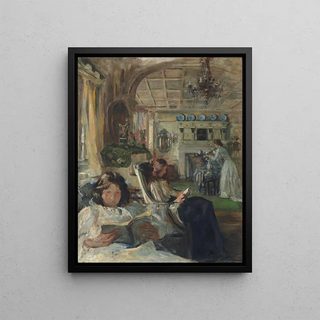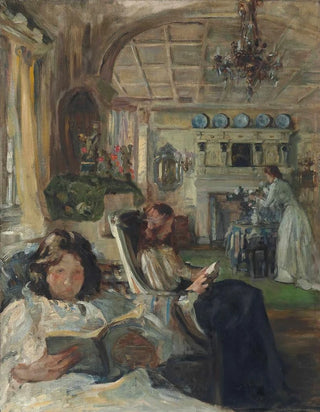Art print | The living room - James Jebusa Shannon


View from behind

Frame (optional)
In the fascinating world of art history, some works manage to capture the very essence of their era while evoking timeless emotions. "The Salon - James Jebusa Shannon" is one of those creations that, through its warm ambiance and intimate atmosphere, transports the viewer into a world where everyday life blends with the extraordinary. This piece, created at the end of the 19th century, offers a valuable glimpse into English bourgeois life, while bearing witness to the undeniable talent of its creator. Through an art print of this piece, one can not only appreciate Shannon's technical virtuosity but also immerse oneself in a frozen moment of life.
Style and uniqueness of the work
The uniqueness of "The Salon" lies in its ability to combine realism and impressionism, two artistic movements that marked the end of the 19th century. Shannon excels in depicting textures and lights, creating an atmosphere that feels almost tangible. The meticulous details of the characters' clothing, the delicacy of the objects present in the scene, and the light filtering through the windows all contribute to a harmonious and captivating composition. Every element of the canvas is carefully arranged, allowing the eye to wander through the scene, discovering subtle interactions between the figures depicted. This work does not merely depict a space; it tells a story, that of a suspended moment where time seems to stand still.
The artist and his influence
James Jebusa Shannon, born in 1862, was an artist whose career was marked by an relentless quest for beauty and truth in art. Raised in an artistic environment, he established himself through his unique style, which blends British influences and impressionist techniques. His work was praised for its ability to capture moments of everyday life with rare sensitivity. Shannon also played a significant role in shaping generations of artists, sharing his expertise and passion for art through classes and lectures. His influence endures, as the themes he explored continue to resonate in the work of contemporary artists.

Matte finish

View from behind

Frame (optional)
In the fascinating world of art history, some works manage to capture the very essence of their era while evoking timeless emotions. "The Salon - James Jebusa Shannon" is one of those creations that, through its warm ambiance and intimate atmosphere, transports the viewer into a world where everyday life blends with the extraordinary. This piece, created at the end of the 19th century, offers a valuable glimpse into English bourgeois life, while bearing witness to the undeniable talent of its creator. Through an art print of this piece, one can not only appreciate Shannon's technical virtuosity but also immerse oneself in a frozen moment of life.
Style and uniqueness of the work
The uniqueness of "The Salon" lies in its ability to combine realism and impressionism, two artistic movements that marked the end of the 19th century. Shannon excels in depicting textures and lights, creating an atmosphere that feels almost tangible. The meticulous details of the characters' clothing, the delicacy of the objects present in the scene, and the light filtering through the windows all contribute to a harmonious and captivating composition. Every element of the canvas is carefully arranged, allowing the eye to wander through the scene, discovering subtle interactions between the figures depicted. This work does not merely depict a space; it tells a story, that of a suspended moment where time seems to stand still.
The artist and his influence
James Jebusa Shannon, born in 1862, was an artist whose career was marked by an relentless quest for beauty and truth in art. Raised in an artistic environment, he established himself through his unique style, which blends British influences and impressionist techniques. His work was praised for its ability to capture moments of everyday life with rare sensitivity. Shannon also played a significant role in shaping generations of artists, sharing his expertise and passion for art through classes and lectures. His influence endures, as the themes he explored continue to resonate in the work of contemporary artists.






